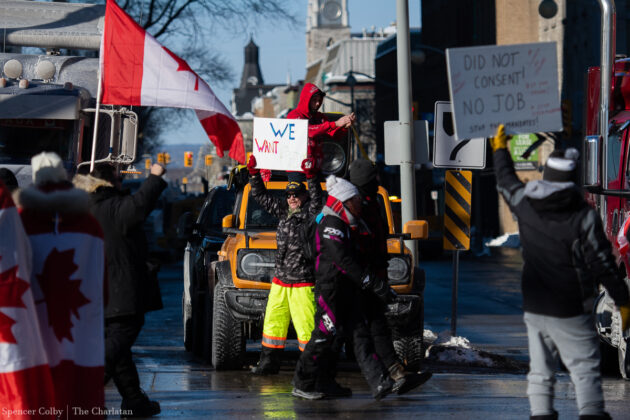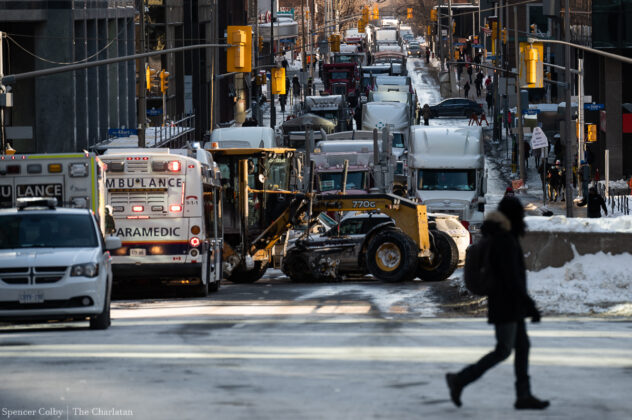
Centretown residents are still reeling from living in fear for nearly a month and experiencing personal and professional disruptions from the ‘Freedom Convoy’ occupation.
The convoy arrived in Ottawa on Jan. 28 to protest vaccine and mask mandates. After weeks of road blockage and noise disturbances, the Ottawa Police Service (OPS) released an official notice warning demonstrators to leave.
“Centretown residents are living in absolute terror,” Coun. Catherine McKenney, who represents the area, said during the occupation. “They are occupied by large trucks, pickups, cars and people who are here to cause a disturbance in their front yards, outside of their bedroom windows and on their front steps.”
The notice followed a hearing on Feb. 16 which extended a temporary injunction from Feb. 7 that barred protestors from using air horns or train horns. Although the first court order was a necessary step, residents say the injunction was not respected, particularly on the Saturday after it was ordered.
On Feb. 14, the federal government invoked the Emergencies Act for the first time in Canadian history, giving police more options to restore order in the city. The act was repealed Feb. 23.
Zexi Li, the main plaintiff of the injunction said the process of removing protestors was slow.
The 21-year-old public servant and Centretown resident said a lawyer in her building recognized her effort to organize a community event for her neighbours to speak with the OPS. Li said he connected her with Paul Champ, the lead lawyer on the class-action lawsuit against the protestors. Together, they enacted the noise injunction designed to stop the honking for 10 days.
Li said she felt some apprehension about being the main plaintiff, adding that many other potential plaintiffs turned down the role for safety concerns.
“But I have it in me to do it, so I should do it,” she said. “The experiences of us, the community, the residents, are always lost. People need to remember that we’re still here, and we exist.”
Paul Lebel, one of the thousands of residents in Centretown and a beauty expert in Rideau Centre’s Shoppers Drug Mart beauty boutique, said he remembers when the protestors first arrived in Ottawa.
“The mall got flooded,” he said. He saw people screaming, drinking, and smoking marijuana in his workplace. “It was just outrageous, so the moment the mall saw, they shut down …We all lost our jobs because of that.”
Lebel said there was no financial support from the government during the occupation. “I managed to make a little bit of work, but it’s nowhere near what I need to sustain myself,” he said.
On Feb. 22, Ottawa police released a notice saying they have shrunk the secured area, which began on Feb. 17, down to Bronson to the Rideau Canal and Wellington Street to Laurier Street. While checkpoints and an increased police presence remain in the downtown core, people can enter for lawful reasons, including supporting local businesses.
As of Feb. 21, police have made 196 arrests with 110 charges laid and 115 vehicles towed.
“It’s really important for people not to buy into the false narrative that this is a peaceful protest,” Li said. She added that she found that some people living outside of Ottawa who did not experience the terror of the occupation struggle to sympathize.
“It shocks me every single time because it just feels that every single time the experiences of us, the community, the residents, is always lost.”
During the occupation, Lebel said he wanted people outside of Ottawa to know how the residents felt terrified.
“This is our home too. This is where we work, where we live and where we spend our time with our families,” he said. “We’re scared.”
According to McKenney, the protests are a reflection of the growing inequity and polarizing political discourse in Canadian society.
“The ‘Freedom Convoy’ is a dangerous movement, but it certainly doesn’t happen without being fed by that type of fuel,” they said.
Featured image by Spencer Colby.







